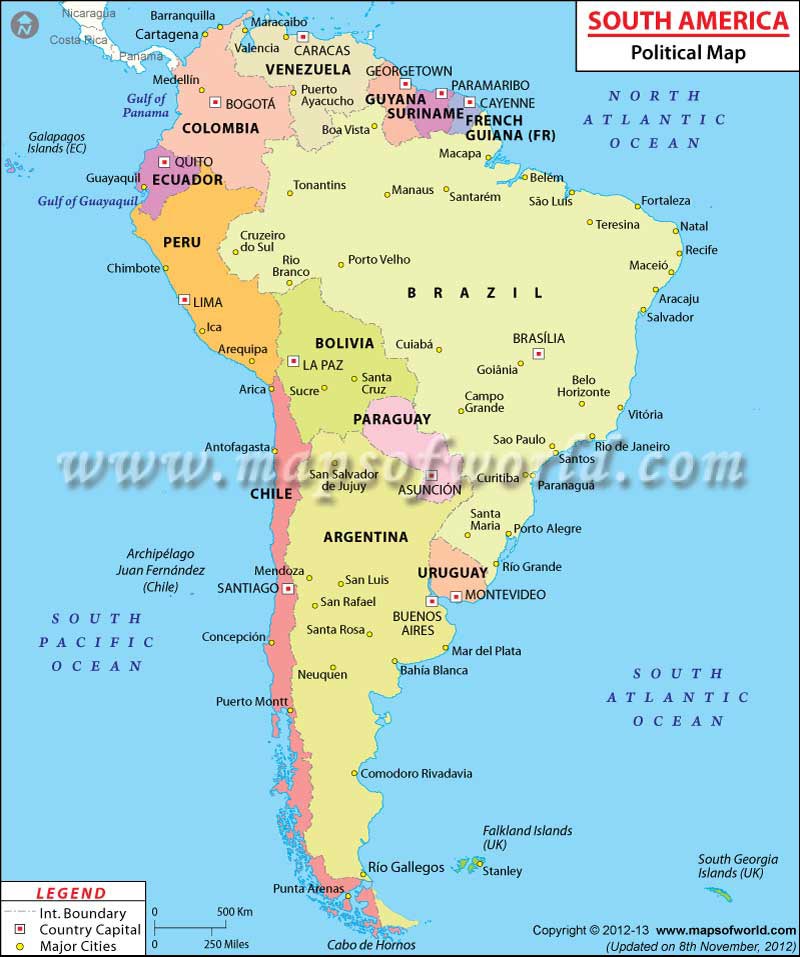South American Countries

×
Disclaimer : All efforts have been made to make this image accurate. However MapSherpa, Inc, its directors and employees do not own any responsibility for the correctness or authenticity of the same.

Disclaimer : All efforts have been made to make this image accurate. However MapSherpa, Inc, its directors and employees do not own any responsibility for the correctness or authenticity of the same.
Countries of South America and their capitals |
|---|
| S.N. | Country and Territory | Area (Sq. Miles) | Capital |
|---|---|---|---|
| 1 | Brazil | 3,287,611 | Brasília |
| 2 | Argentina | 1,068,302 | Buenos Aires |
| 3 | Peru | 496,226 | Lima |
| 4 | Colombia | 439,735 | Bogotá |
| 5 | Bolivia | 424,164 | La Paz and Sucre |
| 6 | Venezuela | 353,841 | Caracas |
| 7 | Chile | 292,260 | Santiago |
| 8 | Paraguay | 157,047 | Asunción |
| 9 | Ecuador | 109,483 | Quito |
| 10 | Guyana | 83,012 | Georgetown |
| 11 | Uruguay | 68,039 | Montevideo |
| 12 | Suriname | 63,039 | Paramaribo |
| 13 | French Guiana (France) | 35,135 | Cayenne (Préfecture) |
| 14 | Falkland Islands (UK) | 4,700 | Port Stanley |
| 15 | South Georgia and South Sandwich Islands (UK) | 1,194 | King Edward Point |
| Quick Facts about South America | |
|---|---|
| Official Name | South America |
| Origin of Name | Amerigo Vespucci |
| International Divisions | 12 independent countries and three territories |
| Population | 387,500,000 (2011 est.) |
| Major Languages | Portuguese, Spanish, English, Dutch, French |
| Major Religion | Christianity (Roman Catholicism) |
| South America Timeline | |
|---|---|
| 5000-1200BC | Asian hunters cross the frozen Bering Strait on their way from Asia to Alaska and then move south. |
| 900-300 BC | Agricultural practices are developed in the highlands of Peru |
| 1400-1550 | The Inca Empire spreads across Bolivia, Chile, Peru, Northern Argentina, and Ecuador |
| 1492 | Christopher Columbus discovers the New World (the Americas) |
| 1494 | Portugal and Spain sign the Treaty of Tordesillas, dividing the land into two sections. Spain controlled the western half, and Portugal controlled the east. |
| 1500 | Amerigo Vespucci recognizes the New World as a separate continent. He is credited for writing his narratives about the voyage and discoveries with great passion and art. The Americas are named after him. |
| 1533 | Spanish Army led by Francisco Pizarro captures much of Inca territory |
| 1535 | Peru and Lima are founded |
| 1536 | Argentina is established |
| 1537 | Paraguay is founded |
| 1693 | Gold is discovered in Brazil |
| 1777 | Administrative units are established in Venezuela |
| 1818 | Chile gains independence from Spain |
| 1821 | Peru gains independence from Spain |
| 1822 | Brazil gains independence from Portugal |
| 1945 | Peru holds free election |
| 1946 | Venezuela holds free election for the first time. |
| 1983 | First free elections are held in Bolivia |
| 2008 | Ecuador adopts a new constitution |